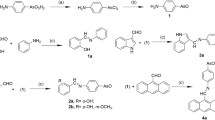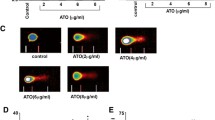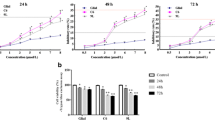Abstract
Though reactive oxygen species (ROS) has been noticed to be involved in arsenic trioxide (As2O3)-induced apoptosis of tumor cells, its role in apoptosis signaling remained to be elucidated. The objective of this work was to explore the association of the inherent cellular ROS level with the susceptibility of the tumor cells to apoptosis induction by As2O3. Low concentration of As2O3 was administered to cultured leukemic cell lines NB4, U937, HL60 and K562. The difference in apoptotic sensitivity was displayed among four cell types. ROS probes were incubated with the cells in the absence of As2O3, and ROS was thus quantified relatively by flow cytometry. We manifested, in four cell types, the inherently existed difference in whole ROS quantity, and a positive correlation between the inherent ROS level and their apoptotic sensitivity to As2O3. Furthermore, by interference using a ROS producer, we demonstrated that an elevation of ROS level would sensitize the cells to As2O3-induced apoptosis. The results of the present work suggested that the inherent ROS level might be determinative in tumor cells for their apoptotic susceptibility to As2O3.
Similar content being viewed by others
References
Shen ZX, Chen GQ, Ni JH, et al. Use of arsenic trioxide (As2O3) in the treatment of acute promyelocytic leukemia (APL): II. Clinical efficacy and pharmacokinetics in relapsed patients. Blood 1997; 89: 3354–3360.
Soignet SL, Maslak P, Wang ZG, et al. Complete remission after treatment of acute promyelocytic leukemia with arsenic trioxide. N Engl J Med 1998; 339: 1341–1348.
Zhu XH, Shen YL, Jing YK, et al. Apoptosis and growth inhibition in malignant lymphocytes after treatment with arsenic trioxide at clinically achievable concentrations. J Natl Cancer Inst 1999; 91: 772–780.
Shi Y, Tan L, Li H, Shi G, Shi X, Tang X Study on arsenic trioxide induced apoptosis in tumor cells of digestive tract. Acta Universitatis Medicinalis Secondae Shanghai 1999; 19: 242–245.
Tan L, Shi G, Shi X, Tang X Induction of apoptosis of human esophageal cancer cell lines treated with arsenic trioxide. China Oncology 1999; 9: 85–87.
Jing YK, Dai J, Chalmers-Redamn RME, Tatton WG, Waxman S Arsenic trioxide selectively induces acute promyelocytic leukemia cell apoptosis via hydrogen peroxidedependent pathway. Blood 1999; 94: 2102–2111.
Wang TS, Kuo CF, Jan KY, Huang H Arsenite induces apoptosis in Chinese hamster ovary cells by generation of reactive oxygen species. J Cell Physiol 1996; 169: 256–268.
Chen YC, Lin-Shiau SY, Lin JK Involvement of reactive oxygen species and caspase 3 activation in arsenite-induced apoptosis. J Cell Physiol 1998; 177: 324–333.
Dai J, Weinberg RS, Waxman S, Jing Y Malignant cells can be sensitized to undergo growth inhibition and apoptosis by arsenic trioxide trough modulation of the glutathione redox system. Blood 1999; 93: 268–277.
Tan L, Shi Y, Shi G, Li H, Shi X, Tang X Study on the mechanism of As2O3-induced apoptosis of human esophageal carcinoma cell lines. Acta Universitatis Medicinalis Secondae Shanghai 2000; 20: 12–17.
Giardina C, Boulares H, Inan MS NSAIDs and butyrate sensitize a human colorectal cancer cell line to TNF-alpha and Fas ligation: The role of reactive oxygen species. Biochim Biophys Acta 1999; 1448: 425–438.
Moreno-Manzano V, Ishikawa Y, Lucio-Cazana J, Kitamura M Selective involvement of superoxide anion, but not downstream compounds hydrogen peroxide and peroxynitrite, in tumor necrosis factor-alpha-induced apoptosis of rat mesangial cells. J Biol Chem 2000; 275: 12684–12691.
Smith JA, Weidemann MJ Further characterization of the neutrophil oxidative burst by flow cytometry. J Immunol Methods 1993; 162: 261–268.
Shi MM, Kugelman A, Iwamoto T, Forman HJ Quinoneinduced oxidative stress elevates glutathione and induced gamm-glutamylcysteine synthetase activity in rat lung epithelial L2 cells. J Biol Chem 1994; 269: 26512–26517.
Liu SS, Huang JP Coexistence of a "reactive oxygen cycle" with the "Q cycle" in the respiratory chain-a hypothesis for generating, partitioning, and functioning of superoxide in mitochondria [A]. In: Proceedings of the International Symposium on Natural Antioxidants: Molecular Mechanisms and Health Effects[C], (USA) Champaign: AOCS Press, 1996: 513–529.
Papa S, Skulachev VP Reactive oxygen species, mitochondria, apoptosis and aging. Mol Cellu Biochem 1997; 174: 305–319.
Allen RG, Tresini M Oxidative stress and gene regulation. Free Radic Biol 2000; 28: 463–499.
Chapple IL Reactive oxygen species and antioxidants in inflammatory diseases. J Clin Periodontol 1997; 24: 287–296.
Lee TC, Wei ML, Chang WJ, et al. Elevation of glutathione levels and glutathione S-transferase activity in arsenic-resistant Chinese hamster ovary cells. In Vitro Cell Dev Biol 1989; 25: 442–448.
Cai X, Shen YL, Zhu Q, et al. Arsenic trioxide-induced apoptosis and differentiation are associated respectively with mitochondrial transmembrane potential collapse and retinoid acid signaling pathways in acute promyelocytic leukemia. Leukemia 2000; 14: 262–270.
Lee TC, Ho IC Differential cytotoxic effects of arsenic on human and animal cells. Environ Health Perspect 1994; 102 (Suppl 3): 101–105.
Shibanuma M, Kuroki T, Nose K Superoxide as a signal for increase in intracellular pH. J Cell Physiol 1988; 136: 379–383.
Fadeel B, Ahlin A, Henter JI, et al. Involvement of caspases in neutrophil apoptosis: Regulation by reactive oxygen species. Blood 1998; 92: 4808–4818.
Mates JM, Sanchez-Jimenez FM Role of reactive oxygen species in apoptosis: Implications for cancer therapy. Int J Biochem Cell Biol 2000; 32: 157–170.
Endicott JA, Ling V The biochemistry of P-glycoproteinmediated multidrug resistance. Annu Rev Biochem 1989; 58: 137–171.
Cole SPC, Bhardwaj G, Gerlach JH, et al. Overexpression of a transporter gene in a multidrug-resistant human lung cancer cell line. Science 1992; 258:1650–1654.
Kramer RA, Zakher J, Kim G Role of the glutathione redox cycle in acquired and de novo multidrug resistance. Science 1988; 241: 694–697.
Rappa G, Lorico A, Flavell RA, Sartorelli AC Evidence that the multidrug resistance protein (MRP) function as a co-transporter of glutathione and natural product toxins. Cancer Res 1997; 57: 5232–5237.
Wartenberg M, Ling FC, Schallenberg M, et al. Downregulation of intrinsic P-glycoprotein in multicellular prostate tumor spheroids by reactive oxygen species. J Biol Chem 2001; 276: 17420–17428.
Payen L, Courtois A, Loewert M, Guillouzo A, Fardel O Reactive oxygen species-related induction of multidrug resistanceassociated protein 2 expression in primary hepatocytes exposed to sulforaphane. Biochem Biophys Res Commun 2001; 282: 257–263.
Perkins C, Kim CN, Fang G, Bhalla KN Arsenic induces apoptosis of multidrug-resistant humam myeloid leukemia cells that express Bcr-Abl or overexpress MDR, MRP, Bcl-2, or Bcl-xl. Neoplasia 2000; 95: 1014–1022.
Author information
Authors and Affiliations
Rights and permissions
About this article
Cite this article
Yi, J., Gao, F., Shi, G. et al. The inherent cellular level of reactive oxygen species: One of the mechanisms determining apoptotic susceptibility of leukemic cells to arsenic trioxide. Apoptosis 7, 209–215 (2002). https://doi.org/10.1023/A:1015331229263
Issue Date:
DOI: https://doi.org/10.1023/A:1015331229263




